light TOYOTA tC 2009 Accessories, Audio & Navigation (in English)
[x] Cancel search | Manufacturer: TOYOTA, Model Year: 2009, Model line: tC, Model: TOYOTA tC 2009Pages: 204, PDF Size: 51.41 MB
Page 126 of 204
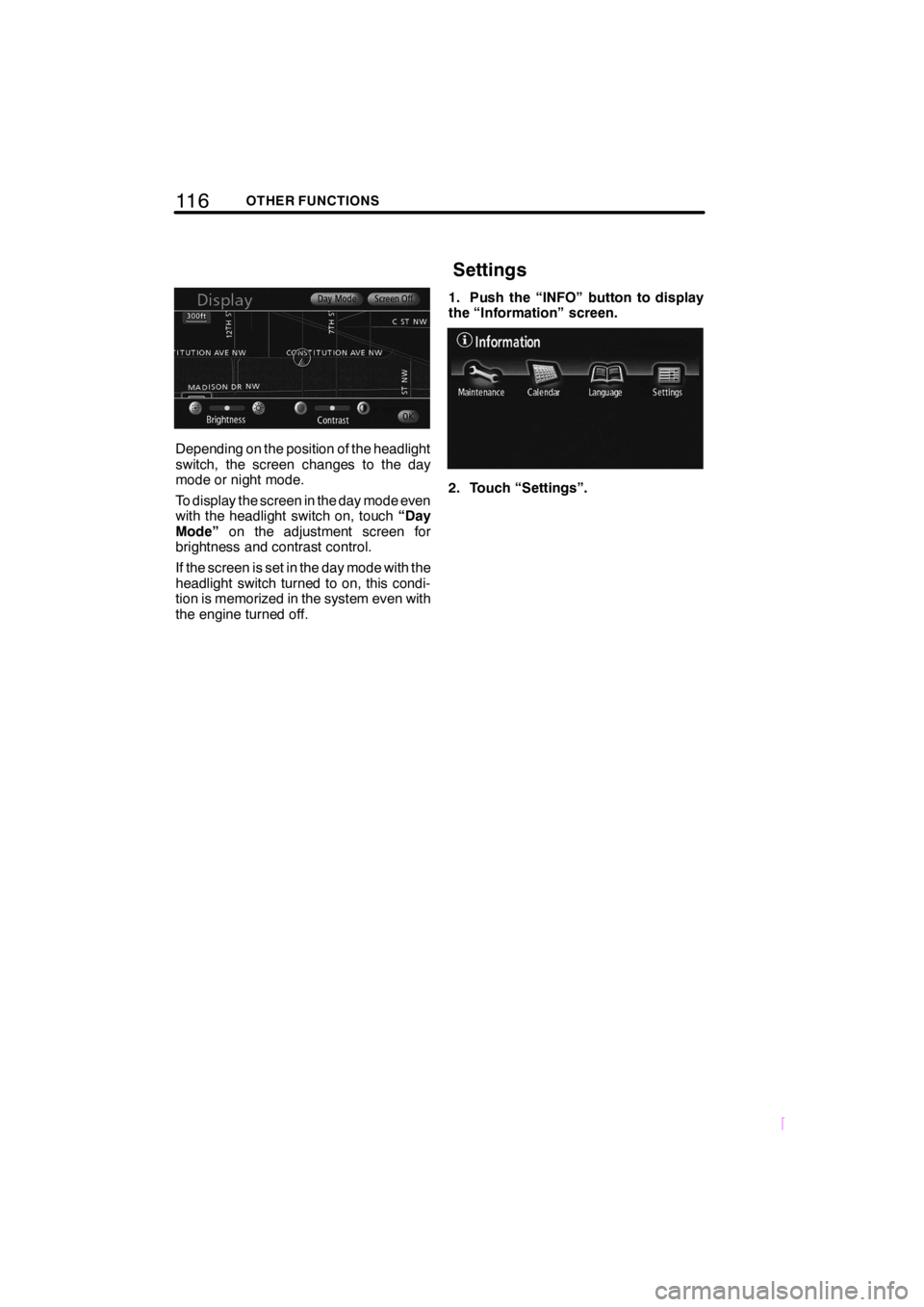
11 6OTHER FUNCTIONS
SCION V398
Depending on the position of the headlight
switch, the screen changes to the day
mode or night mode.
To display the screen in the day mode even
with the headlight switch on, touch“Day
Mode”on the adjustment screen for
brightness and contrast control.
If the screen is set in the day mode with the
headlight switch turned to on, this condi-
tion is memorized in the system even with
the engine turned off.1. Push the “INFO” button to display
the “Information” screen.
2. Touch “Settings”.
Settings
Page 136 of 204
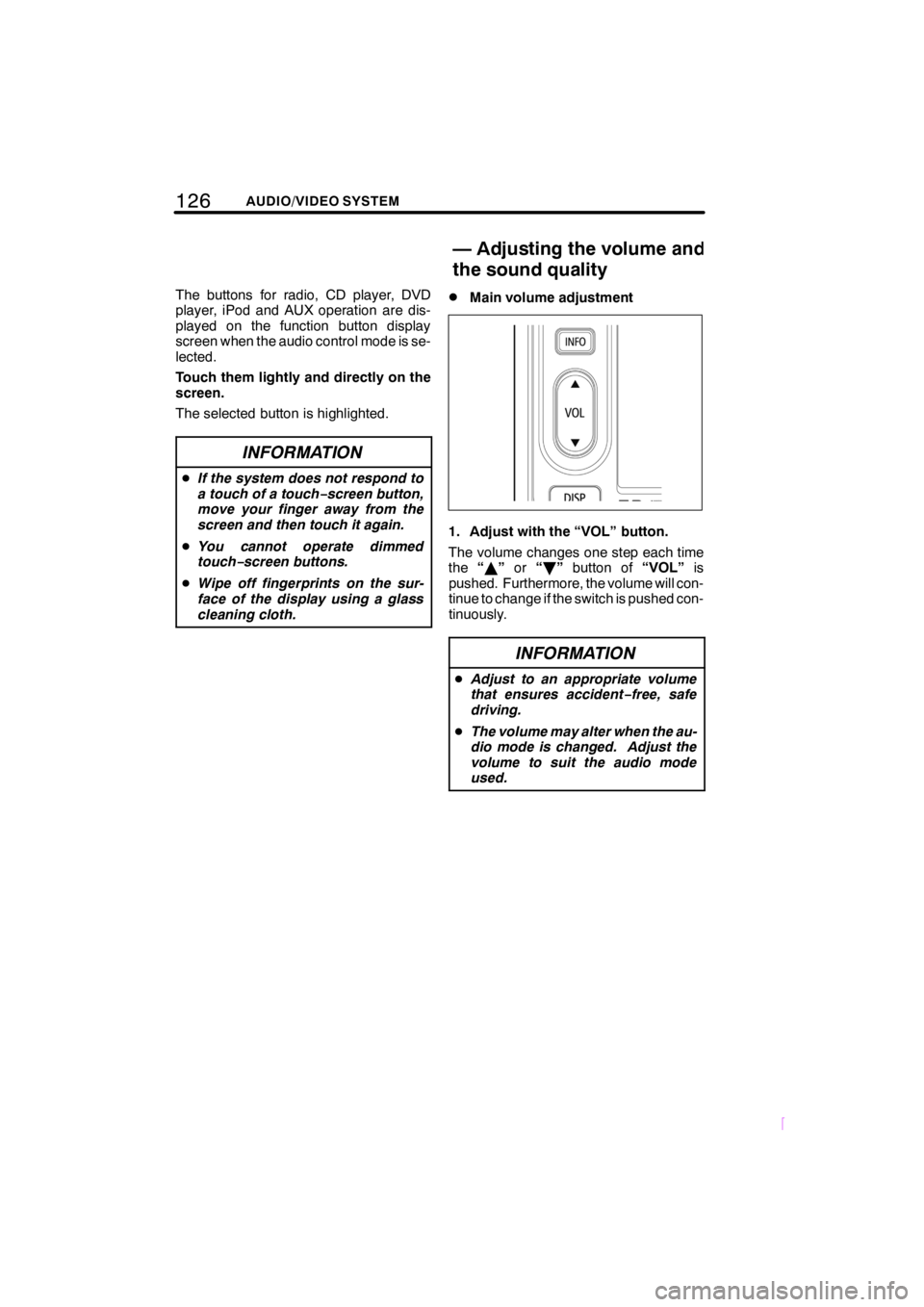
126AUDIO/VIDEO SYSTEM
SCION V398
The buttons for radio, CD player, DVD
player, iPod and AUX operation are dis-
played on the function button display
screen when the audio control mode is se-
lected.
Touch them lightly and directly on the
screen.
The selected button is highlighted.
INFORMATION
DIf the system does not respond to
a touch of a touch−screen button,
move your finger away from the
screen and then touch it again.
DYou cannot operate dimmed
touch−screen buttons.
DWipe off fingerprints on the sur-
face of the display using a glass
cleaning cloth.
DMain volume adjustment
1. Adjust with the “VOL” button.
The volume changes one step each time
the“Y”or“B”button of“VOL”is
pushed. Furthermore, the volume will con-
tinue to change if the switch is pushed con-
tinuously.
INFORMATION
DAdjust to an appropriate volume
that ensures accident−free, safe
driving.
DThe volume may alter when the au-
dio mode is changed. Adjust the
volume to suit the audio mode
used.
—Adjusting the volume and
the sound quality
Page 142 of 204
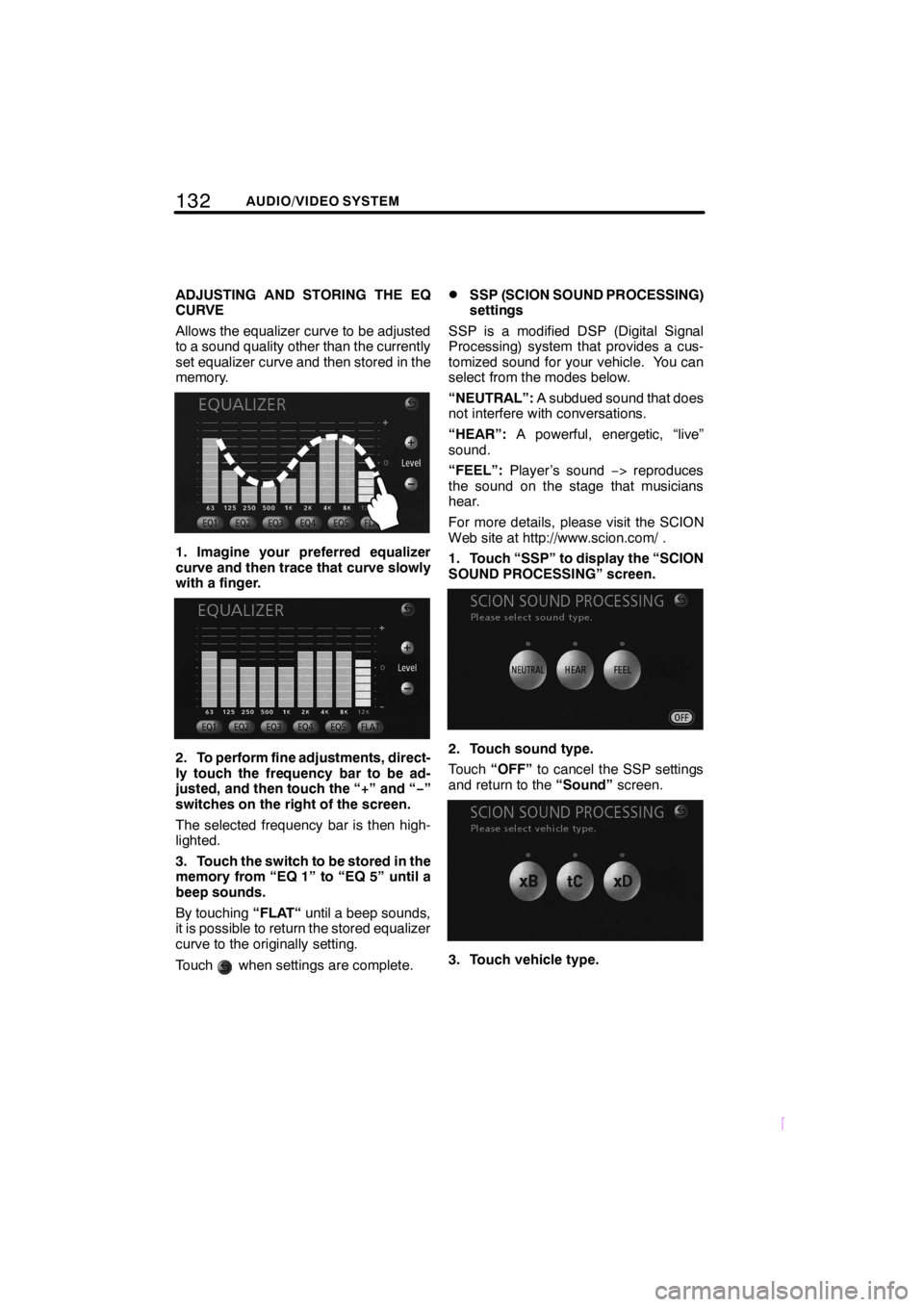
132AUDIO/VIDEO SYSTEM
SCION V398
ADJUSTING AND STORING THE EQ
CURVE
Allows the equalizer curve to be adjusted
to a sound quality other than the currently
set equalizer curve and then stored in the
memory.
1. Imagine your preferred equalizer
curve and then trace that curve slowly
with a finger.
2. To perform fine adjustments, direct-
ly touch the frequency bar to be ad-
justed, and then touch the “+” and “−”
switches on the right of the screen.
The selected frequency bar is then high-
lighted.
3. Touch the switch to be stored in the
memory from “EQ 1” to “EQ 5” until a
beep sounds.
By touching“FLAT“until a beep sounds,
it is possible to return the stored equalizer
curve to the originally setting.
Touch
when settings are complete.
DSSP (SCION SOUND PROCESSING)
settings
SSP is a modified DSP (Digital Signal
Processing) system that provides a cus-
tomized sound for your vehicle. You can
select from the modes below.
“NEUTRAL”:A subdued sound that does
not interfere with conversations.
“HEAR”:A powerful, energetic, “live”
sound.
“FEEL”:Player ’s sound−> reproduces
the sound on the stage that musicians
hear.
For more details, please visit the SCION
Web site at http://www.scion.com/ .
1. Touch “SSP” to display the “SCION
SOUND PROCESSING” screen.
2. Touch sound type.
Touch“OFF”to cancel the SSP settings
and return to the“Sound”screen.
3. Touch vehicle type.
Page 172 of 204
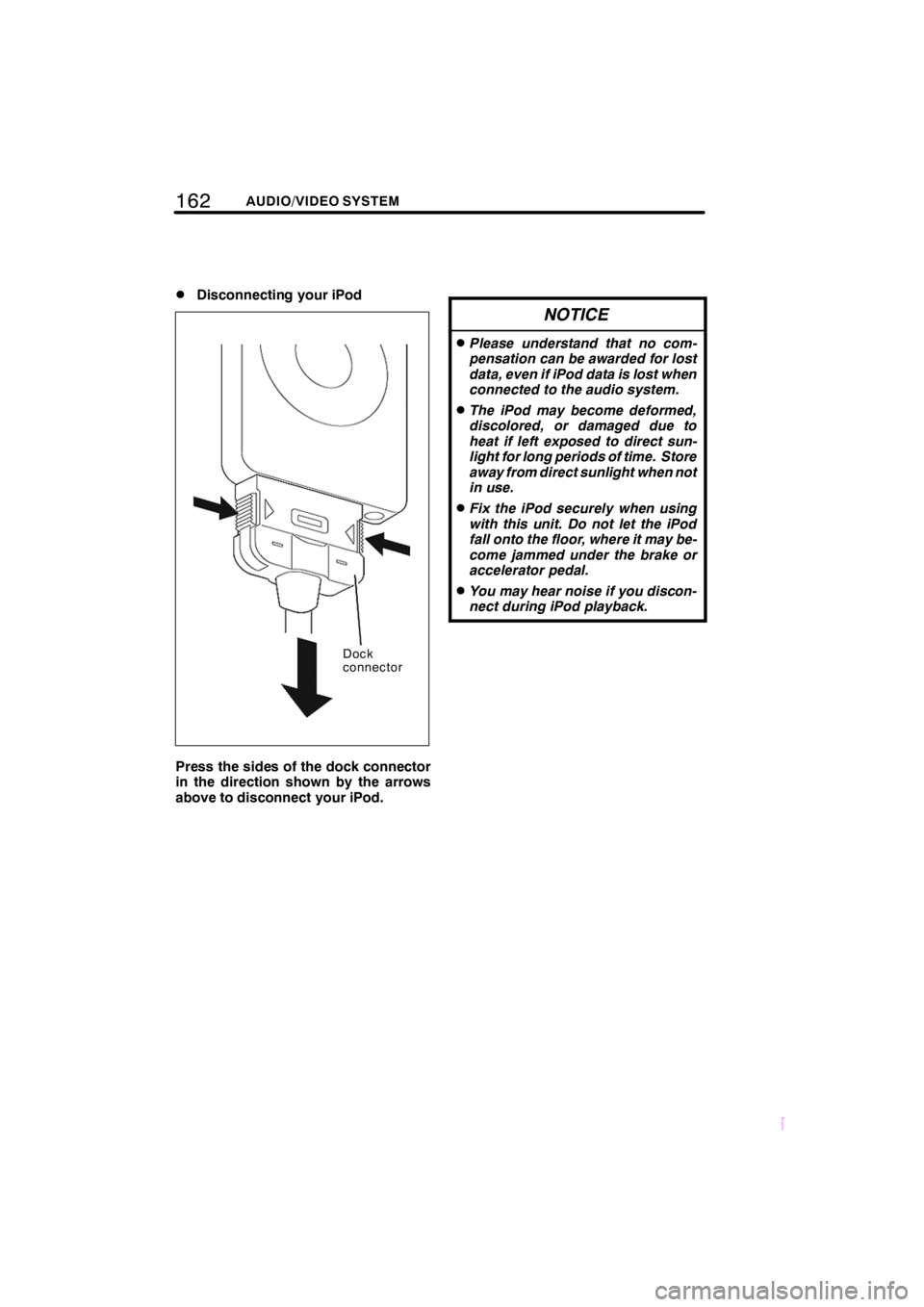
162AUDIO/VIDEO SYSTEM
SCION V398
DDisconnecting your iPod
Dock
connector
Press the sides of the dock connector
in the direction shown by the arrows
above to disconnect your iPod.
NOTICE
DPlease understand that no com-
pensation can be awarded for lost
data, even if iPod data is lost when
connected to the audio system.
DThe iPod may become deformed,
discolored, or damaged due to
heat if left exposed to direct sun-
light for long periods of time. Store
away from direct sunlight when not
in use.
DFix the iPod securely when using
with this unit. Do not let the iPod
fall onto the floor, where it may be-
come jammed under the brake or
accelerator pedal.
DYou may hear noise if you discon-
nect during iPod playback.
Page 178 of 204

168AUDIO/VIDEO SYSTEM
SCION V398
Music stored on commercially available
portable audio devices can be played back
by connecting the devices to the audio sys-
tem. When connecting portable audio de-
vices, it is recommended that an “AUX
adapter” be purchased.
When using portable audio devices with
the audio system, please read over the
portable audio device instruction manual
carefully and ensure that the device is fully
compatible prior to use.
CAUTION
DPlace the portable audio device
and AUX adapter in a location that
will not interfere with SRS airbag
deployment. Failure to do so may
result in death or serious injury due
to the inability of the airbag to func-
tion properly or if the portable au-
dio device is thrown during SRS
airbag deployment.
Refer to the vehicle instruction
manual for details of the SRS air-
bag deployment location.
DAvoid placing the portable audio
device or AUX adapter in a location
that will interfere with driving, or
temporarily secure in a location
that will not interfere with driving.
This may hinder driving or lead to
traffic accidents.
DConnecting (disconnecting) porta-
ble audio devices
NOTICE
DDo not disconnect or connect the
AUX adapter when the display is
open or tilted.
DAvoid getting hands caught in the
AUX adapter terminals.
DDo not connect, operate, or discon-
nect the portable audio device
while driving.
DStore portable audio devices away
from direct sunlight when not in
use.
Ensure that the portable audio device pow-
er is turned OFF.
Ensure that the audio mode is set to a
mode other than AUX, or that the audio
system power is turned OFF.
Connect (or disconnect) the AUX
adapter.
—AUXoperation
Page 179 of 204

169
SCION V398
AUDIO/VIDEO SYSTEM
INFORMATION
DDisconnecting or connecting the
AUX adapter while in AUX mode
may lead to distortion and speaker
damage. Always ensure to turn off
the audio system power or switch
to another mode prior to discon-
necting or connecting.
DChanging the portable audio de-
vice power supply while in AUX
mode may lead to distortion and
speaker damage. Always ensure
to turn off the audio system power
or switch to another mode prior to
changing the portable audio de-
vice power supply.
DPlease note that the volume level
will vary due to differing output lev-
els depending on the connected
device.
DIf the volume is adjusted while in
AUX mode, the volume can be
stored as the volume level for AUX
mode. This stored volume level
will be returned to its default set-
ting if the AUX adapter is discon-
nected.
DWhen using a portable audio de-
vice connected to the power outlet
or cigarette lighter, noise may oc-
cur during playback.
If this happens, use the power
source (battery) of the portable au-
dio device.
DListening to portable audio devices
1. Turn ON the portable audio device
power and playback music.
Refer to the instruction manual provided
with the portable audio device for details of
operation.
2. Push the “MODE” button and touch
“AUX”.
Played back audio from the portable audio
device is output from the speakers.
Page 181 of 204

171
SCION V398
AUDIO/VIDEO SYSTEM
NOTICE
To ensure correct audio/video sys-
tem operations:
DBe careful not to spill beverages
over the audio/video system.
DDo not put anything other than on
appropriate discs into the CD play-
er or DVD player slot.
DThe use of a cellular phone inside
or near the vehicle may cause a
noise from the speakers of the
audio/video system which you are
listening to. However, this does
not indicate a malfunction.
Radio reception
Usually, the problem with radio reception
does not mean there is a problem with your
radio−it is just the normal result of condi-
tions outside the vehicle.
For example, nearby buildings and terrain
can interfere with FM reception. Power
lines or telephone wires can interfere with
AM signals. And of course, radio signals
have a limited range, and the farther you
are from a station, the weaker its signal will
be. In addition, reception conditions
change constantly as your vehicle moves.
Here are some common reception prob-
lems that probably do not indicate a prob-
lem with your radio:FM
Fading and drifting stations— General-
ly, the effective range of FM is about 40 km
(25 miles). Once outside this range, you
may notice fading and drifting, which in-
crease with the distance from the radio
transmitter. They are often accompanied
by distortion.
Multi−path— FM signals are reflective,
making it possible for two signals to reach
your antenna at the same time. If this hap-
pens, the signals will cancel each other
out, causing a momentary flutter or loss of
reception.
Static and fluttering— These occur
when signals are blocked by buildings,
trees, or other large objects. Increasing
the bass level may reduce static and flut-
tering.
Station swapping— If the FM signal you
are listening to is interrupted or weakened,
and there is another strong station nearby
on the FM band, your radio may tune in the
second station until the original signal can
be picked up again.
AM
Fading— AM broadcasts are reflected by
the upper atmosphere — especially at
night. These reflected signals can inter-
fere with those received directly from the
radio station, causing the radio station to
sound alternately strong and weak.
Station interference— When a reflected
signal and a signal received directly from
a radio station are very nearly the same
frequency, they can interfere with each
other, making it difficult to hear the broad-
cast.
Static— AM is easily affected by external
sources of electrical noise, such as high
tension power lines, lightening, or electri-
cal motors. This results in static.
Audio/video system
operating hints
Page 183 of 204
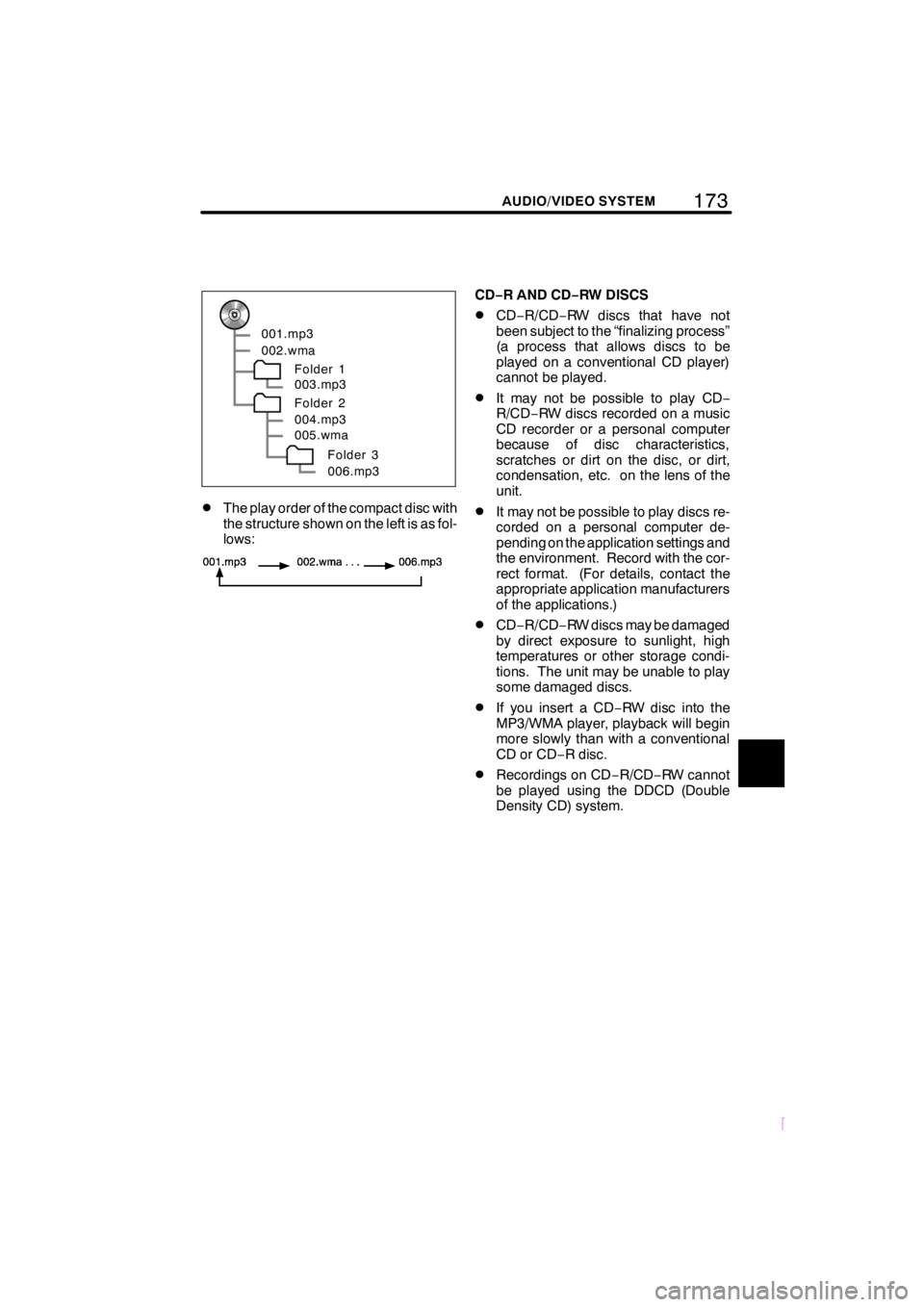
173
SCION V398
AUDIO/VIDEO SYSTEM
001.mp3
002.wma
Folder 1
003.mp3
Folder 2
004.mp3
005.wma
Folder 3
006.mp3
DThe play order of the compact disc with
the structure shown on the left is as fol-
lows:
CD−R AND CD−RW DISCS
DCD−R/CD−RW discs that have not
been subject to the “finalizing process”
(a process that allows discs to be
played on a conventional CD player)
cannot be played.
DIt may not be possible to play CD−
R/CD−RW discs recorded on a music
CD recorder or a personal computer
because of disc characteristics,
scratches or dirt on the disc, or dirt,
condensation, etc. on the lens of the
unit.
DIt may not be possible to play discs re-
corded on a personal computer de-
pending on the application settings and
the environment. Record with the cor-
rect format. (For details, contact the
appropriate application manufacturers
of the applications.)
DCD−R/CD−RW discs may be damaged
by direct exposure to sunlight, high
temperatures or other storage condi-
tions. The unit may be unable to play
some damaged discs.
DIf you insert a CD−RW disc into the
MP3/WMA player, playback will begin
more slowly than with a conventional
CD or CD−R disc.
DRecordings on CD−R/CD−RW cannot
be played using the DDCD (Double
Density CD) system.
Page 186 of 204
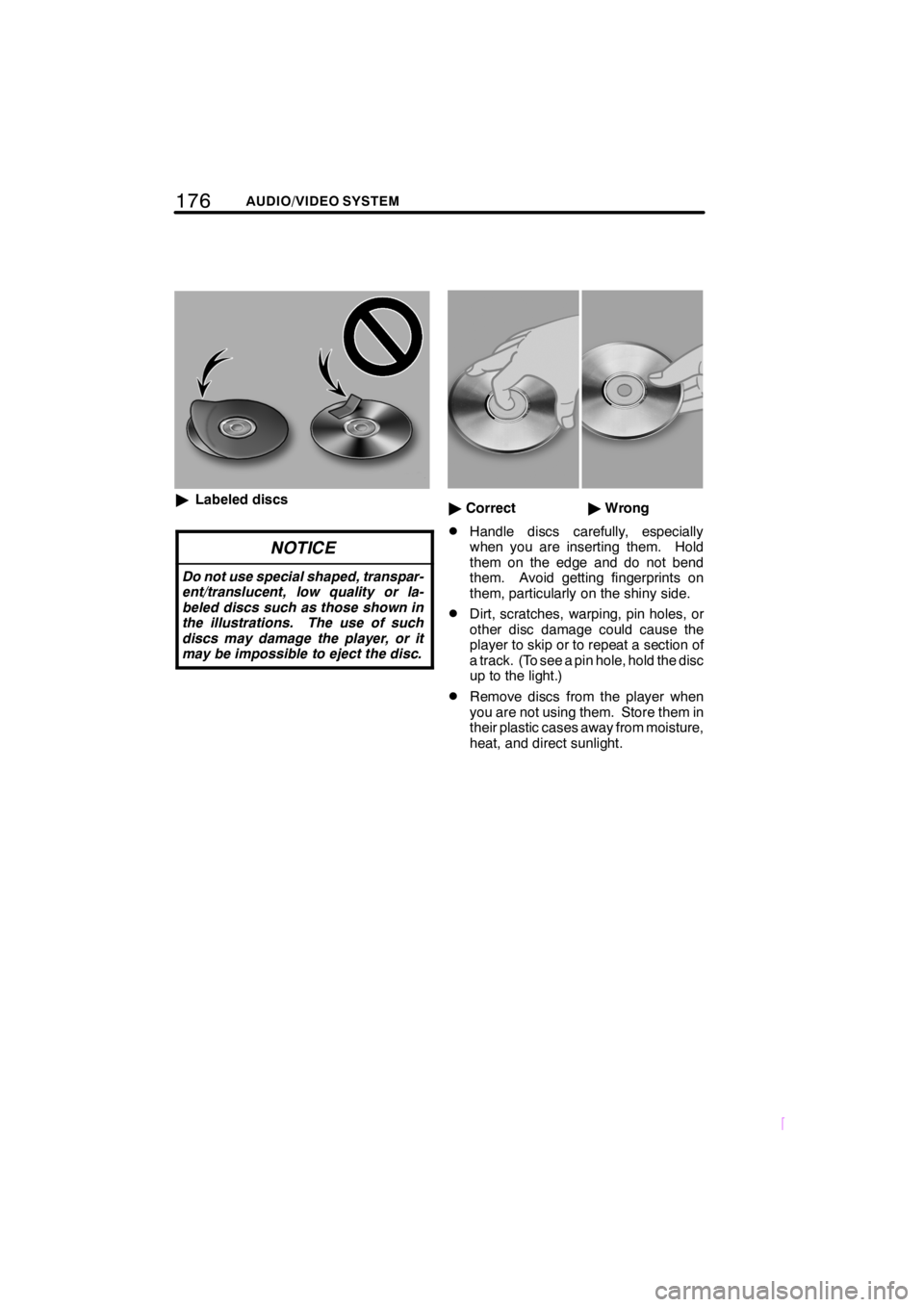
176AUDIO/VIDEO SYSTEM
SCION V398
"Labeled discs
NOTICE
Do not use special shaped, transpar-
ent/translucent, low quality or la-
beled discs such as those shown in
the illustrations. The use of such
discs may damage the player, or it
may be impossible to eject the disc.
"Correct"Wrong
DHandle discs carefully, especially
when you are inserting them. Hold
them on the edge and do not bend
them. Avoid getting fingerprints on
them, particularly on the shiny side.
DDirt, scratches, warping, pin holes, or
other disc damage could cause the
player to skip or to repeat a section of
a track. (To see a pin hole, hold the disc
up to the light.)
DRemove discs from the player when
you are not using them. Store them in
their plastic cases away from moisture,
heat, and direct sunlight.